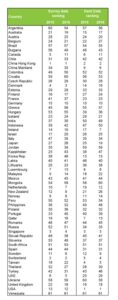
IMD World Competitiveness Ranking: Survey and hard data
Following up on feedback from several readers, in this criterion of the month we explore the IMD World Competitiveness Ranking’s core components: its hard and survey data elements. We divide our overall ranking into these components and rank both sets of data individually for the years 2015 and 2016. The objective is to observe variations in the data in a one-year period. We must emphasize, however, that the two core rankings should not be compared with each other nor with the overall ranking. Rather they should be considered as complement to each other leading to a richer picture of the competitiveness of countries.
On the one hand, hard data lag a minimum of one year behind survey data. In this sense, indicators developed through survey questions (e.g., creation of firms) assess the impact of related hard data indicators (e.g., start-up days and start-up procedures). We thus consider hard data as indicators of competitiveness inputs and survey data as indicators of competitiveness outputs. On the other hand, our survey has been designed to assess fundamental aspects of competitiveness for which hard data are not available (e.g., image abroad of the country) but that are necessary to build a robust assessment of competitiveness.

With this in mind, it is worth noticing that, as expected, fluctuations in the survey data (when comparing the 2015 data to that of 2016) are largely greater than shifts in the hard data for the same period. Shifts in hard data result from any revisions of the indicators’ definition, or from recalculations of previous estimates, by data providers (e.g., IMF). To the extent that this is so, it is difficult to control for the impact of such changes. Fluctuations in survey data may be indicative of the level of optimism/pessimism that prevails in different countries during particular periods of time. In this sense, survey data capture specific socio-political and/or economic events that underline the outlook of respondents and which are to a large extend neglected (if not impossible to capture) by the hard data.
To control for optimism/pessimism’s effect in survey data, in 2015 we incorporated survey questions designed to capture that effect. However, to ensure a fair degree of robustness, it is necessary to employ a time-series of the “controlling” questions in order to trace patterns in the data. We have thus planned to begin assessing optimism/pessimism in our survey in 2017.
Research Information & Knowledge Hub for additional information on IMD publications
LPX AG, founded in 2004 by Michel Degosciu and Robin Jakob, is a leader in listed alternatives, focusing on listed private equity (LPE) and listed infrastructure. With its pioneering LPX Listed Private Equity Index series and NMX Infrastructure In...
Nowadays, deploying artificial intelligence no longer guarantees a competitive edge. What truly sets companies apart is access to diverse, extensive, high-quality data that enhances their AI system’s performance compared with that of their competi...
With stagnant import volumes since 2021, and import prices at levels below those suggested by fundamentals, foreign exporters face an uphill battle to convert access to the Chinese market into revenues. Notably, the volume stagnation predates the ...

Early in his career, Dolf van den Brink did everything he could to project an image of authority – including wearing spectacles he didn’t need. It wasn’t until he learned to be comfortable in his skin that he began to excel as a leader, he tells ...
It has become conventional wisdom to view Europe as an economic powerhouse past its prime, overshadowed by the steady advance of the US and meteoric rise of China. Critics cite Europe’s shrinking share of global GDP, excessive regulation, and slug...
Now in its eighth year, the 2024 IMD World Digital Competitiveness Ranking measures the capacity and readiness of 67 economies to adopt and explore digital technologies as a key driver for economic transformation in business, government, and wider...
The UAE has been making waves recently in the technology world. A $1.5 billion deal between American tech giant Microsoft and Abu Dhabi’s AI champion,G42, seems to mark a shift in global alliances. This deal is significant not just in terms of the...

A balanced assessment of the past eight years is that, in terms of trade policy, America has turned protectionist, implementing significant measures to restrict domestic market access to foreign (non-US) imports.

Key minds behind the Hinrich-IMD Sustainable Trade Index – Deborah Elms, Chuin Wei Yap, Christos Cabolis, and Simon Evenett – explain how decision-makers can benefit from looking at industrial policy in granular detail, given its resurgence and th...
Inflows of foreign direct investment into China shows worrying trends despite its massive economy. While total FDI appears substantial at $163B in 2023, most growth comes from existing foreign subsidiaries rather than new entrants. Foreign manufac...
Research Information & Knowledge Hub for additional information on IMD publications
in MIT Sloan Management Review Winter 2025, no. 2, vol. 66
Research Information & Knowledge Hub for additional information on IMD publications
Research Information & Knowledge Hub for additional information on IMD publications
Research Information & Knowledge Hub for additional information on IMD publications
Research Information & Knowledge Hub for additional information on IMD publications
IMD World Competitiveness Center Report, 14 November 2024, 8th edition
Research Information & Knowledge Hub for additional information on IMD publications
Research Information & Knowledge Hub for additional information on IMD publications
Research Information & Knowledge Hub for additional information on IMD publications
Research Information & Knowledge Hub for additional information on IMD publications
Research Information & Knowledge Hub for additional information on IMD publications

